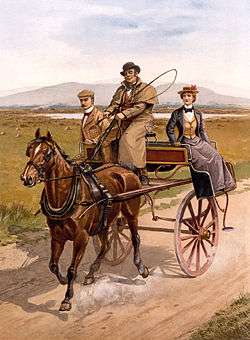Recollections of a Tour Made in Scotland, A. D. 1803

Recollections of a Tour Made in Scotland, A. D. 1803 (1874) is a travel memoir by Dorothy Wordsworth about a six-week, 663-mile journey through the Scottish Highlands from August–September 1803 with her brother William Wordsworth and mutual friend Samuel Taylor Coleridge. Some have called it "undoubtedly her masterpiece"[1] and one of the best Scottish travel literature accounts during a period in the late 18th and early 19th centuries which saw hundreds of such examples.[2] It is often compared as the Romantic counterpart to the better-known Enlightenment-era A Journey to the Western Islands of Scotland (1775) by Samuel Johnson written about 27 years earlier.[3] Dorothy wrote Recollections for family and friends and never saw it published in her lifetime.
The three travelers were important authors in the burgeoning Romanticism movement and thus the trip itinerary was in part a literary pilgrimage to the places associated with Scottish figures significant to Romanticists such as Robert Burns, Ossian, Rob Roy, William Wallace, and contemporary Sir Walter Scott.[4] Dorothy's descriptions and judgments of the countryside and landscapes were a mixture of her own personal aesthetics and the in-fashion aesthetics of the sublime, beautiful and picturesque—in fact Recollections is considered today a classic of picturesque travel writing.[5]
Venturing to Scotland in 1803 was not an easy trip and the thirty-year-old Dorothy would experience much of the rougher nature of Scottish life. Scotland had become depopulated in areas from emigration throughout the 18th century and the remaining rural Scots existed in a preindustrial lifestyle more reminiscent of the Middle Ages than modern times. The roads were poor and dangerous or mere cattle-paths requiring a local guide. Dorothy notes the road quality along each segment from "most excellent", "roughish", to "very bad" to "wretchedly bad". Finding a place to sleep meant finding a public house along the road, which could range from a pleasant inn by English standards, to a dirty and smoky peasants hut with no glass windows nor chimney and a dirt floor. More than once the Wordsworths were refused a room for the night [ such as the Arrochar Hotel] after dark in the rain with miles to the next town; however this was contrasted by the kindness and generosity of others, the MacFarlane's at Loch Katrine.[7] Food in 19th century Scotland along the road ranged from boiled fowl and egg on the high end to whey and oat bread on the low end (or none at all in some cases), although "A boiled sheep's head, with the hair singed off" was a true Scottish fare savored.
Most of the trip was in a jaunting car, an Irish open-air two-wheeled cart drawn by a single horse—which because of the poor roads in practice meant going most of the way on foot. Compared to the more fashionable chaise which other travelers took to Scotland, the jaunting car was a plain and exposed vehicle, which the Wordsworths preferred as they could be travelers instead of tourists and remain approachable to the people of Scotland. There was a central luggage box and two seats facing back to back in which the riders' feet were a foot off the ground.[6] As an Irish design, it was an unusual sight and brought a lot of attention along the way, in part because of rumors circulating at the time that Ireland might soon invade Scotland.[6]
Dorothy wrote the journal over a 20-month period starting in September 1803. "I had written it for the sake of Friends who could not be with us at the time".[6] Her friends admired her Recollections and it soon began to circulate and talk of publication became inevitable. In 1822 Dorothy put together a more refined version, she had lost the original and it was completed from memory, but a publisher was never located.[7] It would not be until 1874, nearly 20 years after her death in 1855, that John Campbell Shairp would publish it for the first time. It sold so well a second edition came soon after including one in the US. Then a third edition in 1894, and then another in 1897. In 1941 it was recognized again when Ernest de Selincourt published a new edition and deemed Recollections "one of the most delightful of all books of travel, and it is, undoubtedly her masterpiece.".[1] In 1997 Yale University Press published an edition by Carol Kyros Walker which is the current definitive edition with hundreds of photographs of Scotland, maps, footnotes and scholarly commentary.(6) There are further versions available including Recollections of a Tour Made in Scotland, A. D. 1803 revised second edition published 2014. This is a paperback with maps and color illustrations of the areas where Dorothy visited with William and Samuel Coleridge.(ISBN 978-0957344327 )
References
- 1 2 Ernest de Selincourt, 1941 edition of Recollections.
- ↑ Kenneth R. Johnston (1998). The Hidden Wordsworth: Poet, Lover, Rebel, Spy. ISBN 0-393-04623-0. Page 800.
- ↑ John Glendening (1997). The High Road: Romantic Tourism, Scotland and Literature, 1720-1820. ISBN 0-312-16174-3. See Chapter 4: The Wordsworths'
- ↑ Michael Ferber ed. (2005). A Companion to European Romanticism. Page 62.
- ↑ John R. Nabholtz, "Dorothy Wordsworth and the Picturesque", in Studies in Romanticism, m 2., Winter 1964
- 1 2 3 Carol Kyros Walker, ed. (1997), Recollections of a Tour Made in Scotland by Dorothy Wordsworth. Yale University Press. ISBN 0-300-07155-8
Further reading
- Carol Kyros Walker, Samuel Taylor Coleridge (2002). Breaking Away: Coleridge in Scotland. Yale University Press. ISBN 0-300-09641-0. Recounts Coleridge's long walk home after he left the Wordsworths half-way through the trip.
External links
- Recollections of a Tour Made in Scotland, A. D. 1803, published by G.P. Putnam's Sons, edited by J. Shairp, 1874 (first edition). From Internet Archive.
- Recollections of a Tour Made in Scotland, A. D. 1803, published by D. Douglas, 1894 (third edition). From Google Books.